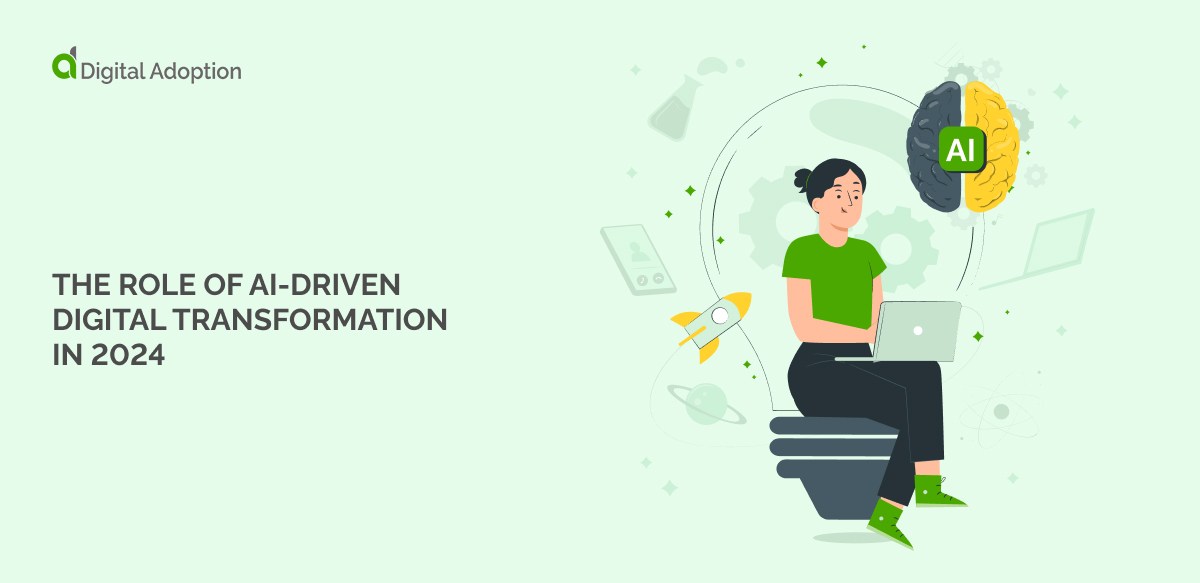ChatGPT took the business world by surprise in 2023, and enterprises are still catching up with their AI adoption using this and similar ChatBot tools in 2024.
This environment makes it essential to consider what an AI-driven digital transformation should look like and its benefits and limitations to accelerate digital transformation and bring investment for a fast ROI.
70% of digital transformations fail, but using AI to drive your large-scale changes could be the key to the success you have been searching for.
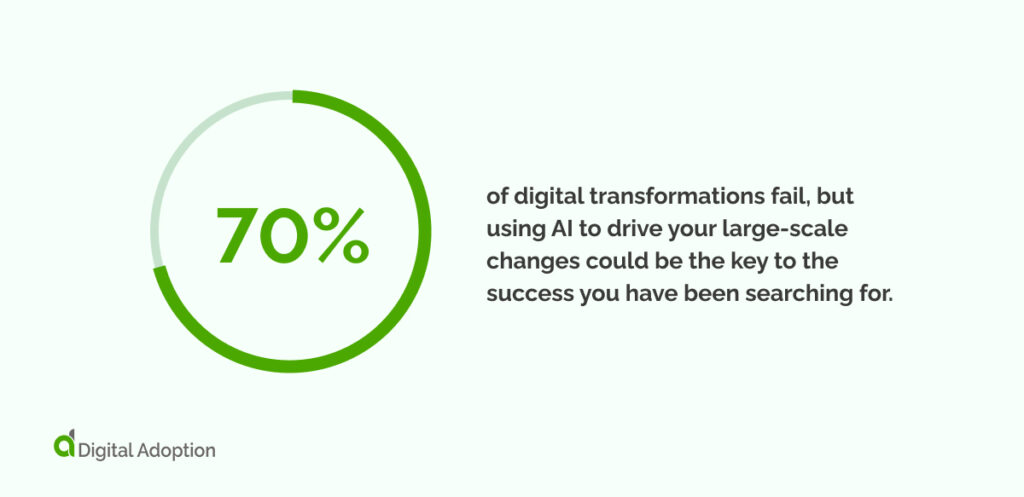
Add to this the fact that enterprise AI adoption hit 35% in 2023, and projections suggest that the global market value of AI will reach USD 738 billion by 2030. It becomes clear that now is the time to invest in AI-driven digital transformation.
This article will dissect AI-driven digital transformation, encompassing its definition, elucidating its significance in 2024, outlining its pivotal role in the current landscape, and delving into the manifold advantages organizations reap from embracing AI-driven digital transformation strategies.
What is AI-Driven Digital Transformation?
Digital transformation is making radical changes to your organization’s operations, and AI-driven digital transformation is simply leveraging AI to make changes most efficiently.
This type of transformation puts automation driven by machine learning and generative AI at the forefront of the tech stack, ensuring that your organization benefits from AI in every way possible to succeed against competitors.
Using AI to steer digital transformations can be beneficial in business IT projects and corporate processes like customer service, software development, and life sciences.
Why is AI-Driven Digital Transformation Important in 2024?
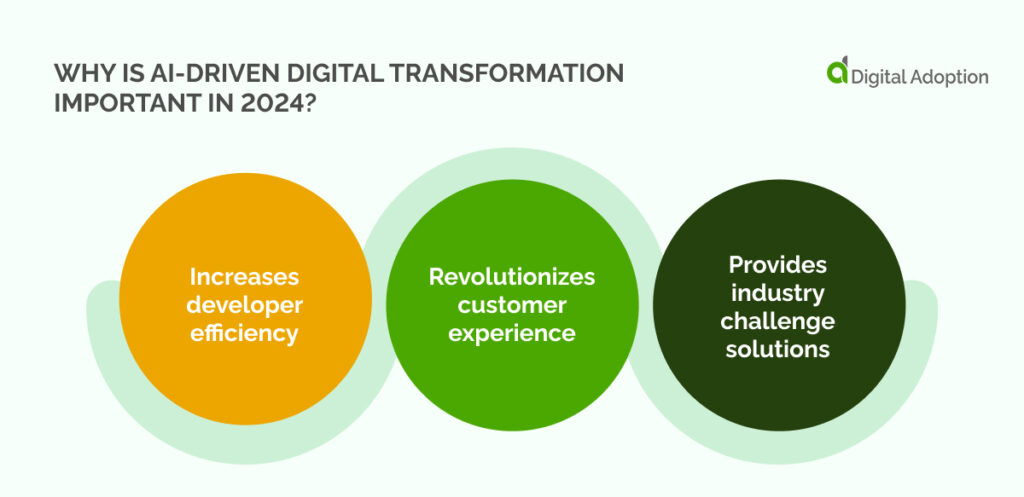
Enterprises have been implementing AI tools for decades now. Still, it was only really in March 2023, when Chat-GPT4 exploded onto the scene, that AI became the most desirable technology every enterprise wanted in their tech stack.
2024 will, therefore, be the year of AI, as more enterprises begin to ensure that generative AI tools like ChatGPT and similar AI tools like Google Bard and Microsoft CoPilot become the tools CEOs want to help their organization stay on top.
There are three reasons why AI-driven transformation is essential in 2024.
Increases developer efficiency
Organizations are adopting generative AI in the form of software coding assistants. Developer productivity is the lowest priority in terms of the adoption of LLMs.
It also enhances developer efficiency by automating repetitive tasks, providing data-driven insights, optimizing workflows, and facilitating rapid problem-solving. These benefits result in accelerated development cycles and improved organizational productivity.
Revolutionizes customer experience
AI transformation is making significant strides in reshaping customer support, placing it at the forefront of business processes. Movate, headquartered in Plano, Texas, specializes in digital technology and customer experience (CX) services.
Approximately 60% of the company’s business operations are centered around CX and technical support services. This is an example of a company where customers primarily engage with the support center through digital channels like the web or chat, using AI as the core of their digital transformation.
Provides industry challenge solutions
AI assumes vital roles in diverse sectors, notably in life sciences. Fujitsu Ltd. and the RIKEN Center for Computational Science collaboratively employ generative AI for drug discovery and analyzing electron microscopy images.
This innovative approach predicts protein structural changes, envisioning a groundbreaking life sciences platform that drastically streamlines drug discovery timelines and costs.
Fujitsu sees generative AI as a transformative force in digital transformation, adept at swiftly navigating the dynamic and unpredictable business landscape of a VUCA (volatility, uncertainty, complexity, and ambiguity) world.
Consider why AI-driven digital transformation is essential in 2024 to realize why you should invest in this approach to stay ahead of competitors and maintain success.
The Role of AI-Driven Digital Transformation in 2024
The role of AI in any digital transformation has changed from several decades ago when it was a minor technology in its infancy.
In 2024, enterprises must consider three elements to ensure AI-driven digital transformation success, putting AI at the forefront of all new technology investments:
- AI-driven strategy.
- AI change management support.
- AI-driven Digital Transformation Technologies.
1. AI-driven strategy
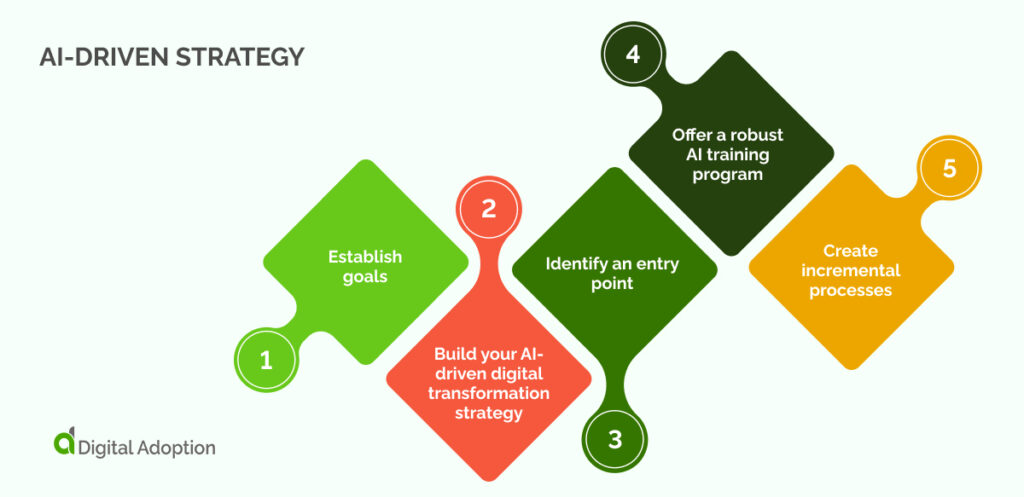
There are five steps to ensuring a robust and successful AI-driven digital transformation strategy, beginning with establishing goals.
Establish goals
Define your primary objectives before embarking on AI transformation to assess its impact on growth. Common goals include reducing operational costs, enhancing efficiency, understanding customer behaviors, and saving time on repetitive tasks.
Start small, focusing on one main goal, implementing AI workflows, and gradually expanding to other areas. Ensure clarity and measurability in your team’s goals, following the SMART (Specific, Measurable, Achievable, Relevant, Time-bound) framework for effectiveness.
A weak goal like “Reduce operational costs” becomes a SMART goal when specifying a 10% reduction in monthly expenses within four months through energy-efficient solutions, supplier contract renegotiation, and streamlined processes.
This comprehensive approach ensures clear objectives and helps minimize costs while maximizing profitability.
Build your AI-driven digital transformation strategy
Now that your goals are set let’s dive into the exciting part: crafting your AI strategy. Outline your goals, strengths, weaknesses, and a three to six-month action plan. Clearly define how success will be measured.
Specify the tools your team should explore, designate leaders, and identify projects for AI integration. Set ground rules, recognizing that while AI is powerful, it requires human input and quality control—combining human creativity with AI talent. Take this opportunity to anticipate potential errors and establish preventive measures.
Identify an entry point
With your strategy set, it’s time to implement your plans. To ease into AI for non-technical users, start with user-friendly tools.
To initiate your AI-driven digital transformation, define clear objectives and assess your organization’s strengths and weaknesses. Start small, experimenting with user-friendly AI tools to build familiarity.
Set measurable goals, integrate AI gradually, and ensure human collaboration for optimal results. Regularly evaluate and adjust your strategy as needed for continuous improvement.
Offer a robust AI training program
Ensuring successful AI adoption involves offering internal training courses to your employees. This builds confidence in using the tools, encourages solution creation, and enhances understanding of optimal utilization.
While AI tool providers may assist with training, additional internal efforts are crucial. This includes suggesting input ideas, integrating AI tools into the existing tech stack, promoting usage among top performers, and celebrating and incentivizing small wins.
Create incremental processes
While demanding, this concluding step proves highly effective when executed. As your team initiates the AI strategy rollout, designate a point person to assess and document each process’s effectiveness.
This evaluation lays the groundwork for crafting standard operating procedures and best practices, ensuring ongoing success. These procedures facilitate scalable operations and accommodate the increasing sophistication of your processes.
2. AI change management support
AI is one of the best examples where staff need change management support as fears of job losses due to automation run high.
Therefore, It is essential to consider the approaches below to ensure staff receive adequate support to implement your change management strategy. At the same time, stress and burnout are low, and employee retention remains high to ensure a human-centered AI approach.
Predictive Analytics
Employing AI to analyze historical and real-time data helps identify patterns and trends, enabling organizations to foresee potential obstacles, resistance, or areas of success in the change management process.
Through predictive analytics, decision-makers can foresee challenges, proactively devise strategies to address them, and minimize risks while maximizing the likelihood of success.
Employee Sentiment Analysis
Leveraging AI-powered sentiment analysis allows evaluating employee attitudes, emotions, and perceptions of change initiatives as you build your AI-augmented workforce.
By scrutinizing data from diverse sources like surveys, social media, and internal communications, AI offers insights into employee sentiment, pinpointing areas requiring additional support, contact, or intervention.
Decision-makers can customize change management strategies to address specific concerns, boosting employee engagement and buy-in.
Recommender Systems
AI-based recommender systems can recommend pertinent resources, training programs, or best practices to employees based on their roles, skills, and needs.
These systems analyze individual and collective data to provide personalized recommendations, aiding employees in adapting to changes more effectively and enhancing their performance during the transition.
Real-time Analytics
AI empowers organizations to analyze data in real-time, furnishing decision-makers with up-to-date insights into the progress and impact of change initiatives.
Real-time analytics help identify bottlenecks, measure the effectiveness of interventions, and facilitate agile decision-making, enabling organizations to make timely adjustments and optimize change management strategies as needed.
Simulations and Scenario Planning
AI-driven simulations can model different scenarios and their potential outcomes, allowing decision-makers to assess the impact of various change management strategies before implementation.
Simulating diverse systems allows organizations to evaluate each approach’s potential risks and benefits, enabling them to make data-driven decisions based on likely outcomes.
Continuous Monitoring and Feedback
AI-driven monitoring systems can consistently collect and analyze data related to change initiatives, offering decision-makers real-time feedback on progress, adoption rates, and areas requiring attention.
3. AI-driven Digital Transformation Technologies
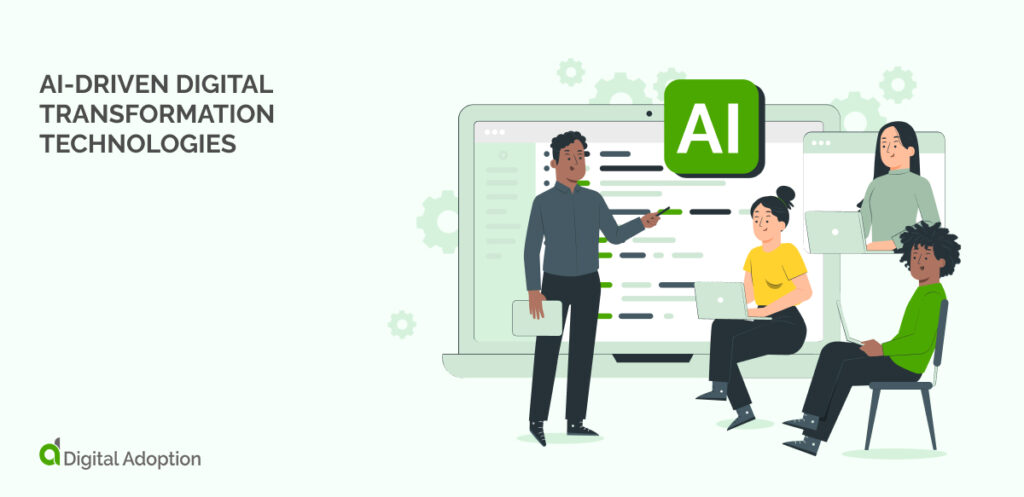
Entering 2024, the substantial influence of artificial intelligence (AI) on digital transformation becomes more apparent. AI is not a distant vision; it propels innovation, efficiency, and competitiveness in various industries. Discover below how AI trends will fuel digital transformation in 2024.
Elevated Customer Experiences
AI transforms experiences, enhancing customer satisfaction and loyalty through personalized interactions and other tools and experiences.
Technologies for this include:
- Tailored personalization: AI-driven algorithms analyze extensive datasets to offer customers highly personalized recommendations, content, and product selections, cultivating loyalty and boosting sales.
- Interactive AI: Advanced chatbots and virtual assistants with natural language processing (NLP) capabilities deliver seamless and efficient customer support, resulting in heightened satisfaction and loyalty.
- Voice and visual search: AI-powered voice recognition and image analysis technologies facilitate more intuitive and efficient search and shopping experiences, significantly enhancing e-commerce platforms.
Data Insights and Analytics
AI-driven transformation revolutionizes data insights analytics, enhancing efficiency and informed decision-making.
Technologies for this include:
- Anticipatory analytics: AI models predict trends, consumer behavior, and market dynamics with exceptional accuracy, enabling businesses to make proactive decisions, optimize resources, and capitalize on opportunities.
- Real-time analytics: AI processes vast data streams in real-time, enabling organizations to swiftly respond to changing conditions, from adjusting pricing strategies to optimizing supply chains.
- AI-enhanced business intelligence: AI automates data preparation, visualization, and reporting, democratizing data access across organizations and empowering decision-makers.
Operational Efficiency and automation
AI-driven transformation enhances efficiency, automating operations for streamlined and optimized performance.
Technologies for this include:
- Robotic Process Automation (RPA): AI-powered bots automate repetitive tasks and processes, reducing errors, enhancing efficiency, and liberating human talent for more strategic activities.
- Streamlined supply chain: AI optimizes supply chain operations by forecasting demand, managing inventory, and minimizing transportation costs, ensuring smoother logistics and cost savings.
- Quality control and maintenance: In manufacturing, AI-driven vision systems and sensor arrays ensure product quality, decrease defects, and minimize downtime through predictive maintenance.
Healthcare Evolution
AI transforms healthcare, accelerating innovation and improving patient outcomes and experiences.
Technologies for this include:
- Medical imaging: AI aids healthcare professionals by analyzing medical images, improving diagnostic accuracy, and expediting patient care.
- Drug discovery: AI accelerates drug discovery by analyzing extensive datasets, predicting potential drug candidates, and expediting development.
- Telemedicine progress: AI-powered telemedicine and remote patient monitoring systems enhance healthcare accessibility and efficiency, reducing the burden on traditional healthcare infrastructures.
Financial Services Advancement
AI propels finance, advancing services with precision, security, and strategic insights.
Technologies for this include:
- Algorithmic trading: AI-driven trading algorithms analyze market data, execute trades swiftly, and effectively manage portfolios.
- Credit risk assessment: AI evaluates creditworthiness using alternative data sources, broadening access to financial services for underserved populations and streamlining lending processes.
- Fraud detection: AI identifies fraudulent activities in real-time, fortifies security, safeguards financial assets, and protects sensitive customer data.
Sustainability and Energy
Sustainability and energy concerns can benefit from AI driving your digital transformation.
Technologies for this include:
- Intelligent energy grids: AI optimizes energy distribution, reducing waste, costs, and carbon footprints while enhancing the reliability of energy systems.
- Climate modeling: AI assists in climate modeling, aiding governments and organizations in making informed climate change mitigation and adaptation decisions.
- Green technologies: AI-driven innovation accelerates the development and optimization of renewable energy systems, making them more efficient and economically viable.
Cybersecurity Reinforcement
The evergrowing concerns around cybersecurity can be resolved using a digital transformation using AI.
Technologies for this include:
- Threat Detection and Response: AI-enhanced security systems detect and respond to cyber threats quickly and accurately, fortifying overall cybersecurity postures.
- Behavioral Analysis: AI examines user and system behavior to identify anomalies and potential security breaches, mitigating risks more effectively.
- Phishing Prevention: AI-powered email security systems detect and prevent phishing attempts, reducing the likelihood of successful cyberattacks.
Education Revolution
AI-driven digital transformation will fuel the education revolution via tailored learning, administrative efficiency, and accessibility initiatives.
Technologies for this include:
- Tailored learning: AI tailors educational content and assessments to individual students’ needs, fostering better learning outcomes and engagement.
- Administrative efficiency: AI streamlines administrative tasks in educational institutions, reducing overhead costs and improving administrative efficiency.
- Accessibility initiatives: AI enhances accessibility by providing tools and materials for students with disabilities, promoting inclusivity in education.
Advantages of AI-Driven Digital Transformation
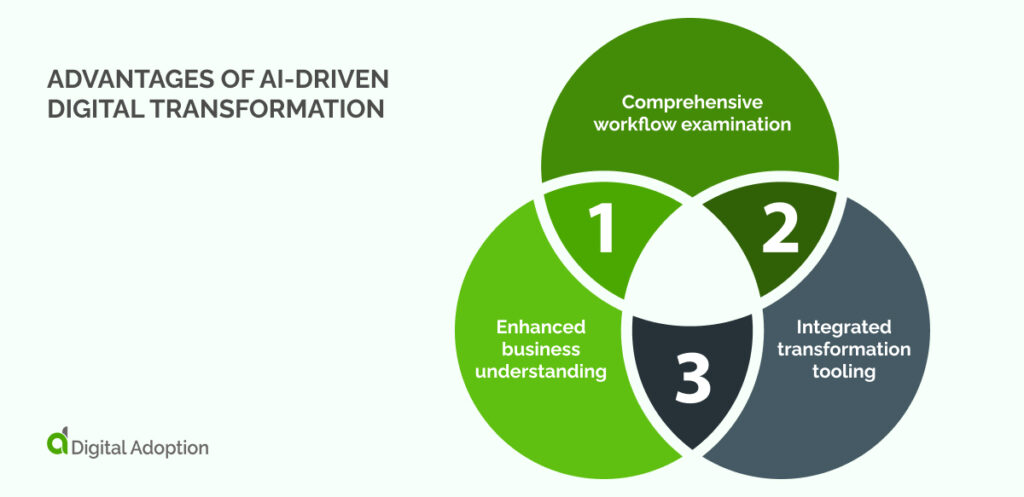
Despite its limitations, AI-driven digital transformation has many advantages to be aware of to ensure you need to invest in this technology. These advantages benefit business understanding, workflow, and transformation tooling.
Enhanced business understanding
AI enables in-depth analysis of vast data sets, empowering organizations with profound insights into their business drivers. This knowledge empowers business leaders to steer digital transformation initiatives efficiently.
AI’s more accurate insights enhance the effectiveness of digital transformation by providing precise data-driven guidance. AI eliminates guesswork, ensuring transformation efforts align with a company’s needs, market trends, and customer demands.
The ability to swiftly process large datasets and identify patterns leads to informed decision-making, resulting in more successful and impactful transformations.
Comprehensive workflow examination
Generative AI opens doors to holistic transformations, surpassing incremental improvements and expanding the scope of digital transformation.
Organizations can use generative AI to assess each step in a workflow process, identifying areas for improvement or cost reduction. Generative AI facilitates addressing tasks previously deemed challenging or lacking clear ROI, offering a cost-effective approach to experimentation.
Integrated transformation tooling
AI integrates into various dimensions of digital transformation, including essential subcomponents like data readiness, as used by Stellar, an AI services provider in Indianapolis. For instance, a business may need to establish new data schemas as the foundation for a new AI application.
AI tools, such as those developed by Stellar, assist in constructing the data layer supporting the top-tier system. Flinchum highlighted the deployment of a cloud data warehouse as a standard step in this process. While the initial schema may not be 100% accurate, AI tools accelerate data readiness.
IBM Consulting employs a tool from its IBM proprietary AI advisor toolkit to enhance internal operations and client delivery. The company has also revamped its Garage Experience toolkit, incorporating generative AI to replace hand-drawn sketches with functional prototypes coded for agile co-development with clients.
Get Ahead of Competitors with AI-Driven Digital Transformation
AI-driven digital transformation becomes the conduit through which enterprises can unlock the transformative power of hyper-personalization, data insights, and operational efficiency. It’s about elevating customer experiences to unprecedented heights, streamlining operations with newfound efficiency, and making decisions backed by rich, data-driven insights.
The integration of predictive analytics, automated processes, and cutting-edge technologies exemplifies the tools at your disposal. Generative AI, in particular, emerges as a beacon, allowing organizations to keep pace with market trends and catalyze themselves ahead. This tool empowers enterprises to anticipate future developments, adapting strategies proactively rather than reactively.
Embracing the future of business innovation isn’t just a recommendation; it’s a prerequisite for sustained success. And the landscape is not just evolving. It’s becoming increasingly reliant on the agility and intelligence that AI-driven digital transformation provides.
As enterprises navigate this landscape, those who actively adopt and integrate AI will survive and thrive, setting the stage for a new era of unprecedented possibilities and achievements in the business world.

